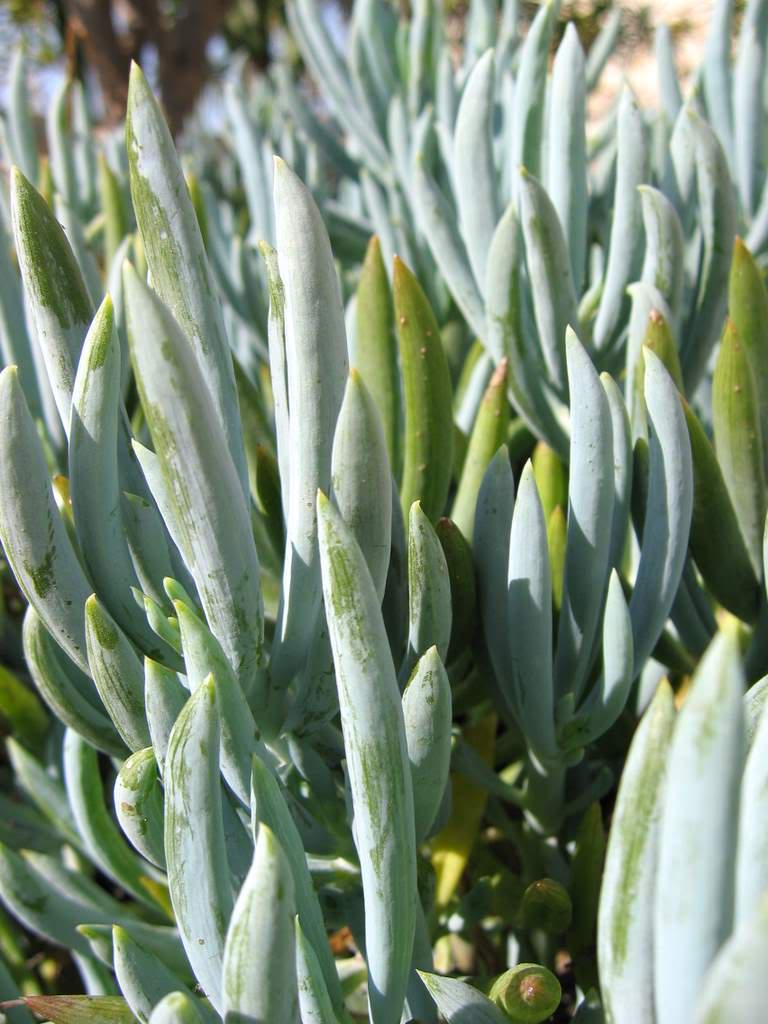I saw cactus one winter
>> Thursday, February 10, 2011 –
cactus,
succulents,
travel
Over the past decade I've made several trips to Los Angeles for business, but most of those trips were during spring or summer. Only one time did I leave the cold and snow of wintry St. Louis and get to enjoy the sunny warmth of southern California: in late January 2006. Luckily my wife and I planned ahead and booked an extra day so we could do something fun, and we chose to visit The Getty Center.
Perhaps January isn't the best time of year to visit, but we were more than pleased with the weather, and spent a really enjoyable few hours touring the museum and gardens before heading to the airport.
The textures and colors are wonderful!
The Getty Center is up on the top of a hill (or is it a small mountain?), overlooking the 405 freeway. You can see it in the background:
It's easy to forget the outside world while you're here.
All of the above photos were taken in the Cactus Garden at the Center, which you can only view from a distance. (For some reason they though it wouldn't be a good idea to let people mingle with these plants.)
The Central Garden is where you can get up-close and personal with plants. There were a lot of non-spiny succulents that caught my eye:
 |
| This is a beautiful combination. |
Actually, that last one may have had some spines -- not sure. There were smaller scale succulents too:
 |
| Not sure if these are Sempervivums or Echeverias. |
 |
| Echeveria. If I grew this I'd have to bring it indoors in the winter. |
There was a good variety of plants, most (all?) of which are not cold-hardy enough for me to grow in the ground and expect to survive the winter. Some really beautiful plant combinations though.
 |
| I like the curvy snake-like leaves in this one. |
 |
| I imagine this is a hummingbird magnet |
 |
| I wish I knew what these were. I love the blooms! |
I think what made this afternoon so special was that most of the plants were unknown to me. For instance, I have no idea what this next plant is, but I love it:
When you have no idea what a plant is, it's pretty difficult to look it up. Is it a reed of some sort? I'm hoping somebody who lives and gardens in California will be able to help me out here.
Even though that trip was five years ago, every winter about this time I look over the photos again and fondly remember our warm, sunny afternoon in the gardens of The Getty Center.
.


















The plant that you love so much is called a restio. I just discovered them a couple months ago. They are really interesting but difficult to grow I've heard because all new growth is in the winter. Propating them is also difficult because their seeds need some sort of smoke treatment to germinate with any success. There are a lot of people in the UK growing them with success and you can read up on them in some UK garden forums . Zone 7+ So I'm definitely out of luck.
Thanks TC! I'll do some research.
Alan, awesome is the word! I agree, the plant combinations are phenomenal, and you captured them exquisitely in your photos.
I can ID some plants. The round cacti of course are golden barrels (Echinocactus grusonii). The columnar ones are queen of the night (Cereus hildmannianus ssp. uruguayanus). The agaves are Agave americana ‘Marginata’. The blue groundcover under the tree aloes is blue chalk fingers (Senecio mandraliscae).
The rosette-forming succulents are all echeverias. The green one is most likely Echeveria elegans.
As TC said, the reed-like plant is a restio. I'm not a restio expert, but it could be Elegia capensis.
Whew...
Thanks for the IDs Gerhard. I didn't know Agave got so large -- those must be almost 6' tall, although it was hard to judge scale.
Agave americana (the common century plant) can easily get to 6-8 ft high and at least that wide. The regular non-variegated century plant is quite common in the Sacramento Valley, especially on older rural properties, but it has naturalized to a degree so you find it growing along freeways and in other unexpected places.
The flower stalk is a sight to see--sometimes 25-30ft tall. I'll make an effort to photograph some nicer looking specimens this summer.
Sometime during my childhood -- either before or just after I attended HS -- there was a photo in the paper of the HS greenhouse with a flower spike poking 15' through the roof. I remember the story saying that it was century plant and that a student had watered it too much, which caused it to flower. There was a photo of a hawk sitting on the top of it.
If you like the look of the restio, but want to try something easier, I have heard that saltcedar does well there.
I love the way they look, but it is a constant fight to keep them off the property. They are a highly invasive, fast growing "tree weed" here in the desert.
We already have problems in Missouri with Eastern Red Cedars invading, so I'll pass on the saltcedar. Here's some info if you're interested:
http://www.shawnature.org/stewardship/Cedar.aspx
Cedars invade everywhere, eh? Hate it when the prettiest are the worst. Like your violets!